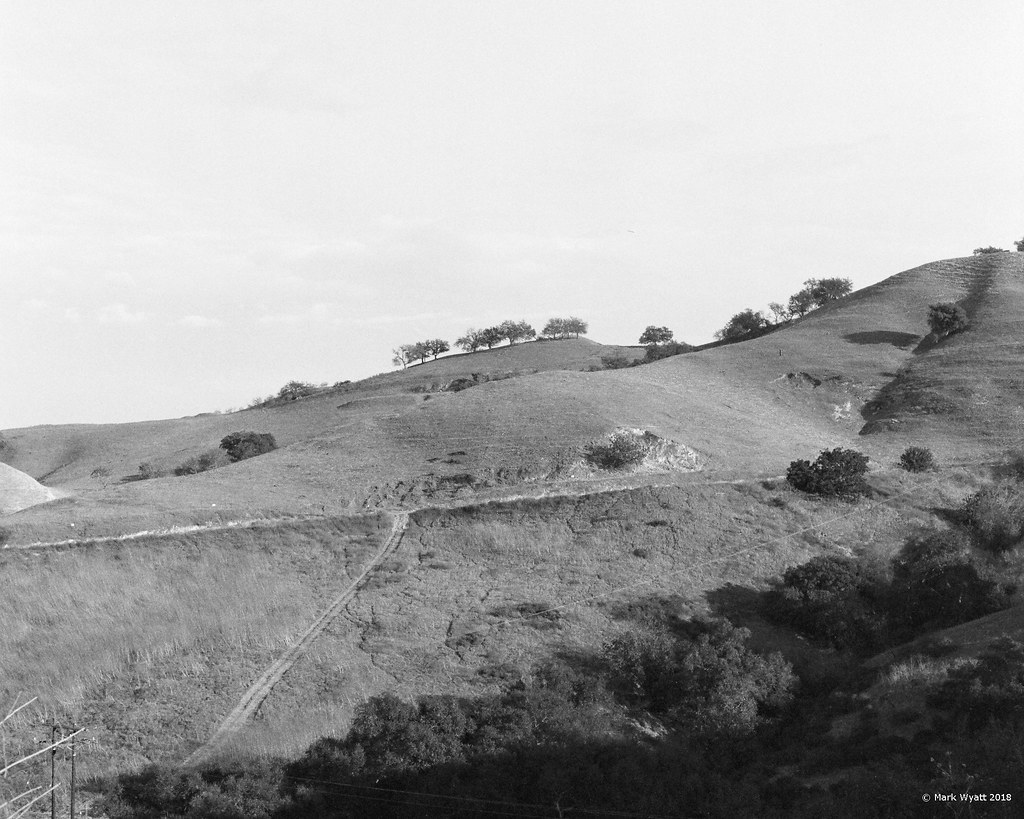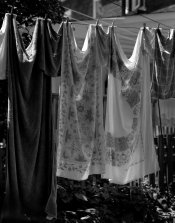markjwyatt
Subscriber
This is an unscientific comparison, but may still be interesting. I shot a roll of Fuji Acros 100 (35mm) and one of Bergger Pancro 400 (120). I have one scene that is fairly close in both film types so thought it might be interesting to compare. In order to compare I used digitized negatives (In picking this section to post, I going by the rule that Simply scanning your Analog work and uploading it, does not make it "hybrid"). Keep in mind given both scenes encompass approximately the same angle of view, and due to the nature of how each as digitized, the 120 film has about 1.5x the linear scan resolution than the 35mm. This is part of the reason (if not all) that you can see utility cables clearly in the 120 shot (lower 1/3 of the scene), but less apparent in the 35mm. I do not intend to discuss digitization, but thought it necessary to mention the difference in scanning resolution to facilitate comparison of the images. Both scenes were shot with "normal" lenses for the format. Note that the grasses in both images are of similar "straw" coloration.
I have yet to get the negatives back for the Pancro 400, but I suspect the exposure for both images was reasonable. I shot the Acros at ISO 100 (negatives have good visual density). On the advice of The Darkroom (based on developing Pancro 400 in DDX), I used ISO 300 for this scene metered "average". I could find very little information on this film/developer combination, so sought the advice.
Scene1: Chino HIlls landscape
Pentax Spotmatic
Carl Zeiss 50mm f1.8 Ultron
Carl Zeiss yellow filter
35mm Fuji Acros 100
Developed (and scanned) by The Darkroom in Ilfotec DDX
Late July 2018; late afternoon

Oaks Landscape by Mark Wyatt, on Flickr
Scene2: Chino HIlls landscaep
Mamiya C330f
Mamiya 80mm f2.8
Hoya X0 yellow-green filter
120 Bergger Pancro 400
Developed (and scanned) by The Darkroom in Ilfotec DDX
Late September 2018; late afternoon

hilly landscape by Mark Wyatt, on Flickr
Both shots were taken in late afternoon; the 120 was clearly closer to sunset. Some clear differences include (Acros/Pancro):
(Fujifilm/Bergger)
ISO (100/400)
format (35mm/6x6cm)
filter (yellow/yellow-green): could account for some tonality differences between the grasses and oaks
lighting (further from sunset/closer to sunset): the Pancro shots have longer more obvious shadows
sky: the Acros shot was shot on a day with more dramatic clouds
cropping: the shots were cropped slightly differently
physical changes: a new trail showed up in the lower 1/3 of the shot in September, and clearly was not there in July.
On the other hand the hillside cracking in the same section looks like it was there in both, but made more apparent due to shadow details in the Pancro (sun position), and may have been enhanced in the Pancro due to either the scanning parameters (1/1.5) and/or the format (35mm/6x6 cm).
Any thoughts on this? Any preference of one film over the other (as opposed to format or scanning density)? I considered a poll, but based on the complexity of the comparison, it would likely be inconclusive.
I have yet to get the negatives back for the Pancro 400, but I suspect the exposure for both images was reasonable. I shot the Acros at ISO 100 (negatives have good visual density). On the advice of The Darkroom (based on developing Pancro 400 in DDX), I used ISO 300 for this scene metered "average". I could find very little information on this film/developer combination, so sought the advice.
Scene1: Chino HIlls landscape
Pentax Spotmatic
Carl Zeiss 50mm f1.8 Ultron
Carl Zeiss yellow filter
35mm Fuji Acros 100
Developed (and scanned) by The Darkroom in Ilfotec DDX
Late July 2018; late afternoon

Oaks Landscape by Mark Wyatt, on Flickr
Scene2: Chino HIlls landscaep
Mamiya C330f
Mamiya 80mm f2.8
Hoya X0 yellow-green filter
120 Bergger Pancro 400
Developed (and scanned) by The Darkroom in Ilfotec DDX
Late September 2018; late afternoon

hilly landscape by Mark Wyatt, on Flickr
Both shots were taken in late afternoon; the 120 was clearly closer to sunset. Some clear differences include (Acros/Pancro):
(Fujifilm/Bergger)
ISO (100/400)
format (35mm/6x6cm)
filter (yellow/yellow-green): could account for some tonality differences between the grasses and oaks
lighting (further from sunset/closer to sunset): the Pancro shots have longer more obvious shadows
sky: the Acros shot was shot on a day with more dramatic clouds
cropping: the shots were cropped slightly differently
physical changes: a new trail showed up in the lower 1/3 of the shot in September, and clearly was not there in July.
On the other hand the hillside cracking in the same section looks like it was there in both, but made more apparent due to shadow details in the Pancro (sun position), and may have been enhanced in the Pancro due to either the scanning parameters (1/1.5) and/or the format (35mm/6x6 cm).
Any thoughts on this? Any preference of one film over the other (as opposed to format or scanning density)? I considered a poll, but based on the complexity of the comparison, it would likely be inconclusive.
Last edited:







